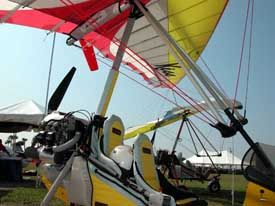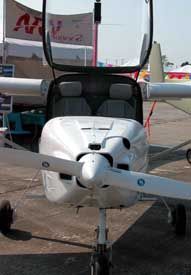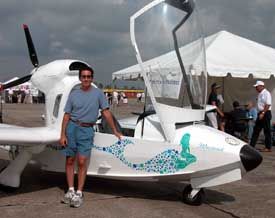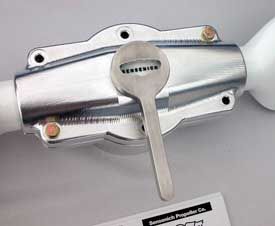 Unlike a lot of “first-year” events, the just-concluded Sebring (Fla.) U.S. Sport Aviation Expo was well-focused, well-organized and well-run. That it wasn’t well-attended is our loss. Not that it was empty, either: All the exhibitor spaces were pre-sold, and a number of industry heavies (Randy Schlitter, Tom Peghiny, John and Martha King, and Tom Poberezny among them) were there. The public that did attend had a feast of information and hardware before them. The attendees were the beginnings of Sport Pilot’s core constituency, and the curious. “The people coming to this show are educated and informed on what they’re looking at. They know what they’re looking for,” said Tracy Standish of RANS, who spent nearly all day, every day, demonstrating the RANS S-7C. (The Coyote II that the factory brought to the show was sold on the first day, so demos weren’t available in that machine.)
Unlike a lot of “first-year” events, the just-concluded Sebring (Fla.) U.S. Sport Aviation Expo was well-focused, well-organized and well-run. That it wasn’t well-attended is our loss. Not that it was empty, either: All the exhibitor spaces were pre-sold, and a number of industry heavies (Randy Schlitter, Tom Peghiny, John and Martha King, and Tom Poberezny among them) were there. The public that did attend had a feast of information and hardware before them. The attendees were the beginnings of Sport Pilot’s core constituency, and the curious. “The people coming to this show are educated and informed on what they’re looking at. They know what they’re looking for,” said Tracy Standish of RANS, who spent nearly all day, every day, demonstrating the RANS S-7C. (The Coyote II that the factory brought to the show was sold on the first day, so demos weren’t available in that machine.)
 That was the great part of this show — its focus. Unlike so many fly-ins and air shows, the Sport Aviation Expo concentrated on small aircraft, Sport Pilot/Light-Sport Aircraft and ultralights. Unlike the more-usual air shows and fly-ins, the vendors were nearly all focused on the show’s message. No jewelry, trendy sunglasses, and potted-plant vendors clogged up the space. And the aviation vendors were available to the serious-buyer types who came. The Expo was a feast for the tiny-aircraft buyer. Company principals and industry shakers (including the ASTM’s Daniel Schultz and EAA’s Earl Lawrence) were on hand and accessible. Demo rides, increasingly rare at mega-shows, were plentiful, and the powered parachutes, trikes, and airplanes from the Expo gracefully shared Sebring’s airspace with the airport’s regular traffic.
That was the great part of this show — its focus. Unlike so many fly-ins and air shows, the Sport Aviation Expo concentrated on small aircraft, Sport Pilot/Light-Sport Aircraft and ultralights. Unlike the more-usual air shows and fly-ins, the vendors were nearly all focused on the show’s message. No jewelry, trendy sunglasses, and potted-plant vendors clogged up the space. And the aviation vendors were available to the serious-buyer types who came. The Expo was a feast for the tiny-aircraft buyer. Company principals and industry shakers (including the ASTM’s Daniel Schultz and EAA’s Earl Lawrence) were on hand and accessible. Demo rides, increasingly rare at mega-shows, were plentiful, and the powered parachutes, trikes, and airplanes from the Expo gracefully shared Sebring’s airspace with the airport’s regular traffic.
 EAA President Tom Poberezny told AVweb that “The show has two purposes: to bring the new [Sport Pilot] community together” (to introduce pilots, manufacturers, and support organizations) and “to promote the airport as a year-around Sport Pilot center.” With Rotax training/rebuild/service center Lockwood Aviation on the airport, it’s a natural venue for such a place, and with mild weather year-around (hurricanes aside) and a friendly, full-service airport, why not? “This specific event can become an anchor as a year-around center for Sport Pilot [activities] and training,” Poberezny said. “It reaches a well-targeted audience — it’s not a typical ‘air show.’ It’s focused on a brand-new segment of commerce. Here, the audience pre-qualifies itself.” New? “Ultralight and LSA-type aircraft have existed a long time,” Tom said, “but now there is a vehicle for licensing and training, a [clearinghouse] for safety issues.”
EAA President Tom Poberezny told AVweb that “The show has two purposes: to bring the new [Sport Pilot] community together” (to introduce pilots, manufacturers, and support organizations) and “to promote the airport as a year-around Sport Pilot center.” With Rotax training/rebuild/service center Lockwood Aviation on the airport, it’s a natural venue for such a place, and with mild weather year-around (hurricanes aside) and a friendly, full-service airport, why not? “This specific event can become an anchor as a year-around center for Sport Pilot [activities] and training,” Poberezny said. “It reaches a well-targeted audience — it’s not a typical ‘air show.’ It’s focused on a brand-new segment of commerce. Here, the audience pre-qualifies itself.” New? “Ultralight and LSA-type aircraft have existed a long time,” Tom said, “but now there is a vehicle for licensing and training, a [clearinghouse] for safety issues.”
 People at the show are those, he said, who “… are looking. They’ve maybe been interested in flying all their lives, but never started to fly. They’ve been wanting [Sport Pilot] info [and now that it’s official], here’s their forum.” Though the Sport Pilot Rule was announced at Oshkosh, Poberezny continued, “We didn’t have a good idea of the implementation.” Here, he noted, the players are together, and the “real questions” are on the table. “We have 50 NAFI flight instructors here,” he noted, underlining the importance the instructor corps detects in Sport Pilot. “They’re here because they want to know more.”
People at the show are those, he said, who “… are looking. They’ve maybe been interested in flying all their lives, but never started to fly. They’ve been wanting [Sport Pilot] info [and now that it’s official], here’s their forum.” Though the Sport Pilot Rule was announced at Oshkosh, Poberezny continued, “We didn’t have a good idea of the implementation.” Here, he noted, the players are together, and the “real questions” are on the table. “We have 50 NAFI flight instructors here,” he noted, underlining the importance the instructor corps detects in Sport Pilot. “They’re here because they want to know more.”
Unlike a lot of “first-year” events, the just-concluded Sebring (Fla.) U.S. Sport Aviation Expo was well-focused, well-organized and well-run. That it wasn’t well-attended is our loss. Not that it was empty, either: All the exhibitor spaces were pre-sold, and a number of industry heavies (Randy Schlitter, Tom Peghiny, John and Martha King, and Tom Poberezny among them) were there. The public that did attend had a feast of information and hardware before them. The attendees were the beginnings of Sport Pilot’s core constituency, and the curious. “The people coming to this show are educated and informed on what they’re looking at. They know what they’re looking for,” said Tracy Standish of RANS, who spent nearly all day, every day, demonstrating the RANS S-7C. (The Coyote II that the factory brought to the show was sold on the first day, so demos weren’t available in that machine.)
That was the great part of this show — its focus. Unlike so many fly-ins and air shows, the Sport Aviation Expo concentrated on small aircraft, Sport Pilot/Light-Sport Aircraft and ultralights. Unlike the more-usual air shows and fly-ins, the vendors were nearly all focused on the show’s message. No jewelry, trendy sunglasses, and potted-plant vendors clogged up the space. And the aviation vendors were available to the serious-buyer types who came. The Expo was a feast for the tiny-aircraft buyer. Company principals and industry shakers (including the ASTM’s Daniel Schultz and EAA’s Earl Lawrence) were on hand and accessible. Demo rides, increasingly rare at mega-shows, were plentiful, and the powered parachutes, trikes, and airplanes from the Expo gracefully shared Sebring’s airspace with the airport’s regular traffic.
EAA President Tom Poberezny told AVweb that “The show has two purposes: to bring the new [Sport Pilot] community together” (to introduce pilots, manufacturers, and support organizations) and “to promote the airport as a year-around Sport Pilot center.” With Rotax training/rebuild/service center Lockwood Aviation on the airport, it’s a natural venue for such a place, and with mild weather year-around (hurricanes aside) and a friendly, full-service airport, why not? “This specific event can become an anchor as a year-around center for Sport Pilot [activities] and training,” Poberezny said. “It reaches a well-targeted audience — it’s not a typical ‘air show.’ It’s focused on a brand-new segment of commerce. Here, the audience pre-qualifies itself.” New? “Ultralight and LSA-type aircraft have existed a long time,” Tom said, “but now there is a vehicle for licensing and training, a [clearinghouse] for safety issues.”
People at the show are those, he said, who “… are looking. They’ve maybe been interested in flying all their lives, but never started to fly. They’ve been wanting [Sport Pilot] info [and now that it’s official], here’s their forum.” Though the Sport Pilot Rule was announced at Oshkosh, Poberezny continued, “We didn’t have a good idea of the implementation.” Here, he noted, the players are together, and the “real questions” are on the table. “We have 50 NAFI flight instructors here,” he noted, underlining the importance the instructor corps detects in Sport Pilot. “They’re here because they want to know more.”


































